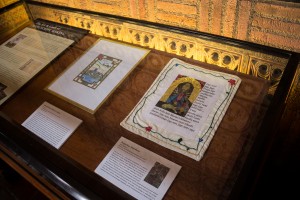One student piece at Thursday’s upcoming Powell exhibit was inspired by an image of a woman beheading her enemy with a tent pole.
The historical document “Judith Slaying Holofernes” was one of many manuscripts displayed in the Getty Center’s 2017 exhibition “Illuminating Women in the Medieval World.” After receiving a preview of the Getty’s exhibition, students of the summer 2017 course History 119D: “Sex in the Middle Ages” created reaction works as part of their final project. Their reaction exhibit, “Inspirational Illuminations: Reacting to Medieval Manuscripts,” will feature a total of 13 works varying in size and medium in the Powell Library Rotunda.
“I wanted students to experience this exhibit not only because it fit well with the themes of my class, but it allowed them to understand the manuscripts beyond text,” said public history initiative lecturer and program coordinator Kristina Markman.
Illuminated manuscripts are elaborate pages of texts and images from the Middle Ages that depict Bible passages, chronicles and adventure stories, Markman said. Medieval patrons paid scribes and illuminators to write their desired passages and decorate them with delicate gold leaf and eye-catching colors created from minerals and insects.
Markman said the goal of the history course was to understand how medieval conceptions of gender inform Western gender identities. Upon seeing the ancient documents, students were surprised by the intricacy of the manuscripts’ pages, but reacted most strongly to the unexpectedly positive medieval representations of women, she said.
In medieval times, Markman said women were understood to be responsible for the fall of man, due to their supposedly lustful nature. However, the Getty exhibition included images of powerful women demanding divorce and fighting against enemy forces.
“We’re used to seeing the medieval archetypes of the damsel in distress and the seductress, but the manuscripts show there’s so much more to female life in the Middle Ages,” she said.
Fourth-year French and history student Jude Larnerd said the exhibit’s representation of women did not match his preconceived notions of medieval women. He said the large influence of patriarchal powers often overshadows the tales of powerful women who challenged the medieval status quo.
“I was inspired by the whole exhibit to project the female thoughts on a platform that’s about women, by women and empowers women,” he said.
On his poster-size, Vogue-inspired magazine cover, Larnerd includes tabloid-like headlines that speak to the medieval social climate. Around the cover of the model are phrases like “88 Ways to Interpret Prayer and Divorce Mortals” and “Heaven, Hell, and Dying Well.”
“I hope viewers will look at medieval women in a different light and understand that they, too, faced similar problems,” he said. “It’s rewarding knowing that people will see my piece and think about it, and recognize the ideas are relevant in both the present and the past.”
Another student in Markman’s class, Shreya Banerjee, a third-year molecular, cell and developmental biology student, centered her work, “Durga Slays Mahishasura: A Medieval Manuscript,” on medieval images of empowered women. Banerjee said she was also surprised by the female representation in the Getty exhibition because she didn’t know medieval people invested so much time and money in depicting empowered women in illuminated manuscripts.
For her mixed-media work, Banerjee said she drew inspiration from the tale of Judith killing Holofernes. The illuminated manuscript’s image of its protagonist beheading the enemy leader with a tent pole reminded her of a similar narrative in Hindu mythology.

The many-armed Hindu goddess Durga and her battle against the demon Mahishasura is similar to Judith’s story and is also depicted in elaborate illustrations. Banerjee used her own photographs of the Indian idol, watercolor and hand embroidery to personalize the project. She also included lyrics of an Indian devotional song praising the goddess in medieval-style script.
“I thought it was a really interesting cross-cultural depiction of one myth that’s really important to me,” she said. “I mixed the Hindu tale with the European format of an illuminated manuscript to show how the image of empowered women spans time and nations.”
Banerjee said she enjoyed seeing women-focused art at the Getty exhibition because it challenged the male-heavy understanding of the Middle Ages. Experiencing the exhibit and creating her own response work made her reflect on misconceptions about the past, she said.
“It was a very powerful depiction of women in medieval ages,” Banerjee said. “I think women in those times had much more autonomy than we actually give them credit for.”
